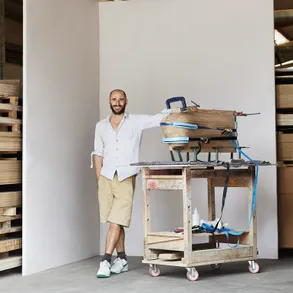
Case Splash Chopping Board
SPLASH CHOPPING BOARD
The Splash Chopping Board designed by Gareth Neal is created using digital manufacturing techniques resulting in a pure geometric design.
Offering versatile use as a chopping or serving board, the Splash Chopping Board is crafted from natural beech.
DESIGNER
GARETH NEAL
A piece created by Gareth Neal is the first thing that visitors see at the Victoria and Albert museum’s furniture gallery. But the soft-spoken Briton actually considers his mission to be much more than just designing and making furniture.

He is passionate about honouring “people, process and place. I try to keep it local,” he said, by championing the use of indigenous materials and traditional processes while at the same time exploring new ones. And he also makes an effort to respect the environment.
In 2012, Neal decided to set a carbon-negative challenge for himself. He and two students from the University of Brighton, where he is a senior lecturer on design and craft, biked 160 miles into the countryside of Herefordshire, where an 80-year-old English ash tree had been cut for a project but then was left there, unused.
Without the benefit of electricity, and using only hand tools — axes, draw knives (which have a long blade with two handles) and pole lathes — the three created a table, four stools and 12 candlesticks, which, he said, “we placed on a cart and biked 160 miles back to London.”
Gareth Neal believes that as a hands-on designer and maker, he is fascinated by process, whether that be with traditional tools or the latest computer controlled router.
This, combined with a fascination of historical techniques and aesthetics, roots his design within a specific context with rich narratives and contextual reference points. Good design emanates from a depth of knowledge of the medium, and his ability to reconsider it for a contemporary audience.
While creating one off pieces, he pushes himself and some of the best craftsman in the UK. He loves working collaboratively, and this provides a rich stream of inspiration within his practice which has cultivated some of their humblest and progressive designs.
Privately, he likes nothing better than a rummage around a car boot sale or junk shop, this in many way has instilled in him a desire to make things that have a longevity and a resistance to fashion, and installed a healthy respect for the environment, and a desire to make sure his studio’s objects stand out and shine for all time.
Gareth Neal lives in the East End of London, which used to be a centre for veneers and marquetry work, “which are all but lost from London,” he said. He paid homage to his neighbourhood’s woodworking roots, as well as to “objects that talk of the woodland,” with his “Urban Picnic” project.
In 2010, Neal entered a competition with the theme “The Great British Weekend.” He decided that “the picnic bench is so simple” and so elemental to British life that he proposed making one, along with other leisure items such as a cricket bat and a hula hoop
. The pieces then would pop up unexpectedly in various parts of the East End, inviting residents to enjoy themselves. The project proposal won its category hands down. “I was one of the judges, and his work stood out,” said Josephine Chanter, head of communications at the London Design Museum. “It was experimental and incredibly beautiful.”
And in honour of the veneer craft that once flourished in the East End he gave the finished pieces intricate “stringing line” inlays made from combinations of geometric pieces of thin veneers.
INFORMATION
KEY FEATURES
- Versatile
- Easy maintenance
- Pure geometric design
PRODUCTION
Made in Poland
PRODUCT TYPE
Chopping Board
BRAND
Case
WEIGHT
0.25 kg
DIMENSIONS
- Height : 86”
- Width : 11”
- Depth : 14.5”
ENVIRONMENT
Kichen
AVAILABLE FINISHES
Oil Treated Beech
DESIGN
Geometric Design
DOWNLOAD
↓ Specification Sheet
CARE INSTRUCTIONS
- Before using for the first time with food or contact with water, we recommend protecting it against grease and moisture by treating it with food safe oil such as mineral oil or sunflower oil. Apply once and wipe off any excess and repeat after 24 hours. Note that this make the colour of the wood richer.
- Should only be cleaned by wiping with a wet cloth or scrubbing brush.
- Not dishwasher safe.
- Do not allow item to soak or be in contact with water for a prolonged time - this can cause the wood to split.
- Carefully dry without using heat to accelerate the drying process.
- Can be rubbed with a fine sandpaper and re-oiled to maintain its condition.





